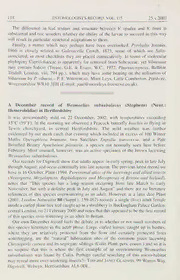
A December record of Wesmaelius subnebulosus (Stephens) (Neur.: Hemerobiidae) in Hertfordshire PDF
Preview A December record of Wesmaelius subnebulosus (Stephens) (Neur.: Hemerobiidae) in Hertfordshire
118 ENTOMOLOGIST'S RECORD. VOL. 115 25.V.2003 The difference in leaf texture and structure between V. opulus and V. tinus is substantial and one wonders whether the ability of the larvae to succeed in this way will result in particular structural adaptations to them. Finally, a matter which may perhaps have been overlooked. Pyrrhalta Joannis, 1866 is closely related to Galerucella Crotch, 1873, some of which are Salix- associated; in most checklists they are placed consecutively. In terms of molecular phylogeny Caprifoliaceae is apparently far removed from Salicaceae, yet Viburnum may contain Salicin (Trease, G.E. & Evans, W.C., 1972. Pharmacognosy. Balliere Tindall, London, viii, 794 pp.), which may have some bearing on the utilisation of Viburnum by P. viburni - P. F. Whitehead, Moor Leys, Little Comberton, Pershore, Worcestershire WR10 3EH (E-mail: [email protected]). A December record of Wesmaelius subnebiilosus (Stephens) (Neur.: Hemerobiidae) in Hertfordshire It was unseasonably mild on 22 December, 2002, with temperatures exceeding 15°C (59°F). In the morning we observed a Peacock butterfly Inachis io flying in Tewin churchyard, in central Hertfordshire. The mild weather was further evidenced by our moth catch that evening which included in excess of 100 Winter Moths Operophtera brumata, two Satellites Eupsilia transversa, and a Pale Brindled Beauty Apocheima pilosaria, a species not normally seen here before February. Most unusual, however, was an active specimen of the brown lacewing Wesmaelius subnebiilosus. Our records for Digswell show that adults appear in early spring, peak in late July through August, and occur continually into late autumn. The previous latest record we have is 16 October. Plant (1994. Provisional atlas ofthe lacewings and allied insects (Nenroptera, Megaloptera, Raphidioptera and Mecoptera of Britain and Ireland), ) notes that ‘This species has a long season occurring from late March to early November, but with a definite peak in July and August” and there are no literature references of this species overwintering as an adult. However, at a later date Plant (2001. London Naturalist 80 (Suppl.): 159-167) records a single (live) adult female inside a curled plane tree leafcaught up in a shrubbery in Buckingham Palace Garden, central London, on 2 1 February 2000 and notes that this appeared to be the first record of this species over-wintering as an adult in Britain. Our own December record fuels the debate as to whether or not small numbers of this species hibernate in the adult phase. Large, curled leaves, caught up in bushes, where they are relatively protected from the frost and certainly protected from waterlogging, are the “natural” hibernation sites of the common green lacewing Chrysoperla earned and its segregate siblings (Colin Plant, pers. comm.) and so it is no surprise that this is where the first example of an overwintering Wesmaelius subnebiilosus was found by Colin. Perhaps careful searching of this micro-habitat may reveal more over-wintering insects?- Tom and Janet Gladwin, 99 Warren Way, Digswell, Welwyn, Hertfordshire AL6 0DL.
